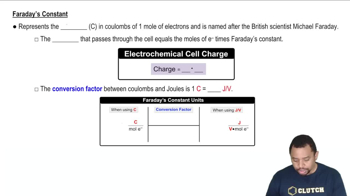A rechargeable battery is constructed based on a concentration cell constructed of two Ag/Ag+ half-cells. The volume of each half-cell is 2.0 L, and the concentrations of Ag+ in the half-cells are 1.25 M and 1.0×10–3 M. a. How long can this battery deliver 2.5 Aof current before it goes dead?
If a water electrolysis cell operates at a current of 7.8 A, how long will it take to generate 25.0 L of hydrogen gas at a pressure of 25.0 atm and a temperature of 25 °C?
 Verified step by step guidance
Verified step by step guidanceKey Concepts
Faraday's Laws of Electrolysis

Ideal Gas Law

Stoichiometry of Water Electrolysis

A rechargeable battery is constructed based on a concentration cell constructed of two Ag/Ag+ half-cells. The volume of each half-cell is 2.0 L, and the concentrations of Ag+ in the half-cells are 1.25 M and 1.0 × 10–3 M. b. What mass of silver is plated onto the cathode by running at 3.5 A for 5.5 h?
A rechargeable battery is constructed based on a concentration cell constructed of two Ag/Ag+ half-cells. The volume of each half-cell is 2.0 L, and the concentrations of Ag+ in the half-cells are 1.25 M and 1.0 × 10–3 M. c. Upon recharging, how long would it take to redissolve 1.00 × 102 g of silver at a charging current of 10.0 amps?
Calculate ∆G°rxn and K for each reaction.
a. The disproportionation of Mn2+(aq) to Mn(s) and MnO2(s) in acid solution at 25 °C.
b. The disproportionation of MnO2(s) to Mn2+(aq) and MnO4–(aq) in acid solution at 25 °C.
